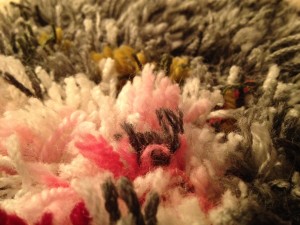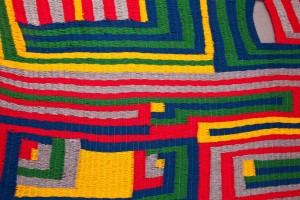Exhibition: Craft Anonymous, Adelaide Town Hall – 9 April – 5 June 2015
Meg Wilson is an artist, designer and arts worker based in Adelaide. In 2012 Adele Sliuzas and I had coffee at Coffee Branch and she asked, “Do you know Meghann Wilson?” At the time, I didn’t. But soon after I met Meg when she moved into Peer Studios. I became increasingly interested in who this unpresumptuous, hardworking, exciting knit-wearing, kind mannered character was. We got to know each other better when Meg asked me to write a catalogue essay for an exhibition she was curating at Format. I agreed to co-write it and suggested that we write a duet. We bonded over nervous lyrics. Now, at Coffee Branch again, in the lead up to Craft Anonymous, Meg and I share coffee, chocolate croissant and tales of her evolving arts practice…
How have things progress after art school? I finished Honours in 2006 and would dabble in either being part of someone else’s show or doing things if I was invited to. But really I was a hobby artist.
What were you doing for employment at that time? After finishing art school I was like, “What the hell am I going to do?” and I started a Graduate Diploma in Teaching and then realised after six-months that I am not a teacher. Then the next year I started Interior Design at Tafe and at the same time started working for a furniture company in design and sales. So selling $30,000 couches! [Laughter]
As you do! How long were you there? Er I was there for 4 years. I decided at the time I moved into Peer Studios [2012] that I would start taking my practice more seriously. I got a part-time job in a design firm as a Studio Assistant and my hours were 9am-3pm, four days a week, in the city. Then I would come to the studio afterwards, which was really good. I didn’t have anything I was working towards but just needed to spend time in the studio and that’s when stuff started happening.
So did you put in a proposal for No Future (at Format from 9-28 November 2012)? I put in a proposal to Format for that show and then Adele at the time was doing her suite of three curated exhibitions to do with ‘the end of the world’ and my theme seemed to fit in with that so she asked if I’d be part of it.

Was I Busy My Hands in Remembrance of you the first textile work you made? I had been working on a combination of painting and textiles since third year but that was probably the first time I worked completely with textiles.
What is I Busy My Hands in Remembrance of you about? I was making the carpet from memory of my grandma’s carpet, from when I was a kid. Trying to recreate it out of what I remembered it being like. And actually found that most people’s grandma’s had that same carpet.
That’s lovely! I started doing it because I was reading Dickens ‘Hard Times’ and there was a sentence within the first few pages where the school headmaster was belittling a little girl because she liked floral carpets and said something like, “What would you want that for? Your husband will just tread his muddy boots all over it.” I was like, “What a horrible thing to tell an eight year old!”
Let her like what she likes! Yeah! And maybe she won’t have a husband! Maybe she’ll tell people to keep their muddy boots off her nice carpet!
Textiles has always been considered a ‘females art’, that always plays out in your work too, doesn’t it? Yeah, I guess it will always be there, even if it’s not what I’m thinking about. There always seems to be that association. I guess it’s something that I’ll be aware of and always be seeing within my work – that’s a good thing! Even my most recent work, which is not textile-based and involves me running a marathon, has its origins in being a female and being told that I couldn’t do something. Looking further into the history of the marathon I’ve realised how loaded it is being a woman running a marathon. Women weren’t allowed to run marathons until the 1970s. It just tends to come out in my work, everywhere, even if it wasn’t the initial intension. Because I’m a female and I’m making that kind of work!
Have you been influenced by various sources as well as Dickens? Various sources. I haven’t read a lot of Dickens, I’ve only read a couple.
How do horror movies influence your work? I guess that interest came from my interest and work within set and theatre design. I like to play with the way a person might feel within a space by trying to alter it and that’s what horror movies do. I also just love the aesthetic of early 60s horror movies – they’re completely absurd and brightly coloured and over the top and I think that’s where my colour palette comes from with a lot of my work. It’s not an obvious association but there’s an underpinning. I tend to take an idea from a text of some kind: a book, a movie, a play and then run with that idea. What I end up with is something quite removed from the original trigger.

Why do you put yourself through repetitive crafts? Because I’m an idiot! [Laughter]
There must be some sort of desire that comes with it? Yeah, it’s the challenge of not knowing if I can do something or not. Most of the textile processes I don’t actually know how to do. I either make it up as I go or I learn it. So most of the ways I am working are usually pretty basic. Generally I will do it in a completely different way the next time.
Or never do it again! No! Never do it again! It gets boring when you actually know how to do it properly. [More laughter]
Is that important to you that it is a simple process that anyone could do? Yeah, I think it probably is. I haven’t ever thought about that.
The domestic home setting is very different to a set, or a place described in a book or the white cube gallery space – how does your interior space relate? Does it draw on the artificiality or play up against that? I guess it is using that space in a non-traditional way. By filling the floor space, filling the doorways, generally it’s the sort of spaces that aren’t necessarily used by other artists, or definitely not filled in. It does two things: it uses the gallery space in a different way but also it changes the way that people operate within that space. Art does that all the time, I’m not the first person to challenge people in that way but I guess by putting it [craft objects] within a gallery space and in an odd way within that space it alters its functionality.
Both I Busy My Hands in Remembrance of you & Flounce will be exhibited in Craft Anonymous.